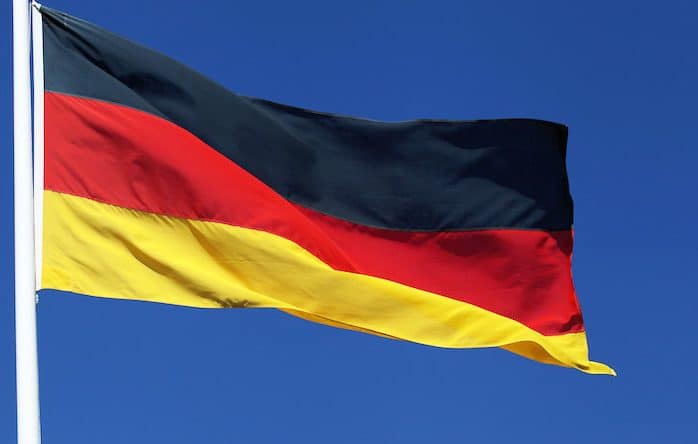
- German Government issues first green bond and starts to build a green yield curve
- New concept of “twin” bonds to avoid negative effects of illiquidity
- Important milestone for the sovereign green bond market as Germany is a key capital market
After the Netherlands and Sweden, Germany has become the third AAA-rated country to issue a green government bond. The German government also announced its commitment to building a full green yield curve, next to its conventional yield curve.
Germany is introducing a new concept of “Green Twin Bonds”, where a green bond is issued with the same maturity and coupon as a conventional bond. The green bond is a separate bond with a smaller issue volume than the conventional bond. The aim of this structure is to ensure that the issuance of green bonds does not negatively influence the overall liquidity in German government bonds. It also makes it easier for there to be a natural diversification between conventional and green bond investors.
The #GreenBund is here! The German Finance Agency issued our first green bond with €33bn demand from global investors. This shows that our innovative approach was well received by markets. A green benchmark is of great importance for our capital market! https://t.co/Y3AkiwksvP
— Jörg Kukies (@joergkukies) September 2, 2020
“We strongly support the issuance of green German government bonds,” says Bram Bos, Lead Portfolio Manager Green Bonds at NN Investment Partners. “The concept of “Green Twin Bonds” is a new and innovative form of green bond issuance we favour. We think this concept is a much better option than the concept currently being explored by the Danish government, which is looking to issue separate green labels or stickers which could be attached to any conventional bond”
Germany is the third AAA-rated country to start issuing green government bonds, after the Netherlands in 2019 and more recently Sweden on 1 September 2020.
“We think this is an important milestone for the green bond market as the German government bond market is one of the most important reference points in the capital markets,” continues Bos. “Clearly the growth of the green bond market keeps on accelerating and the strong increase in government issuance gives more investors the chance to greenify their full fixed income portfolios”
Germany is committed to being almost climate neutral by 2050. In November 2016, the German federal government adopted the Climate Action Plan 2050, making the country one of the first to submit its long-term greenhouse gas emission strategy to the UN, as required under the Paris Agreement. This plan outlines the basic principles for implementing the country’s climate change mitigation strategy to reach 80 to 95 percent reduction in greenhouse gas emissions by 2050 compared to 1990 levels.
On 2 September, Germany issued EUR 6.5 billion worth of bonds with a maturity of 10 years. In contrast to some other countries, like the Netherlands, Belgium and France, the German government plans to build a full yield curve. This gives investors more options to greenify their fixed income portfolio at several different points along the yield curve. After this inaugural green bond, Germany is expected to be a regular issuer, issuing around EUR 10 billion per year in green bonds.
Germany has identified five sectors to which they can allocate the proceeds of their green bonds. These are transport; international cooperation; research, innovation and awareness raising; energy and industry; and agriculture, forestry, natural landscapes and biodiversity.
“Although we think it is a positive development that Germany has started issuing green bonds, the country’s green bond framework is not as clearly aligned with international standards like the Green Bond Principles and the EU and Climate bond Initiative taxonomies as some other green government bonds” says Bos. “For example, a large portion of these green bond proceeds will be allocated to trains and rail infrastructure, which could also include the freight transport of fossil fuels. We miss the ‘do no harm’ assessment in this green bond framework, which is one of the pillars of the EU taxonomy and EU Green Bond standard. However, we also see some positives and commend the German government’s ambition to only allow green hydrogen production in the eligible use of proceeds. Green hydrogen is produced using only renewable energy and the German renewables market is well placed to develop this exciting industry innovation and make it cost competitive.”
Source: NN IP
'It has been my long held belief that objections to green sovereign issuance did not equate with market realities. The German & Swedish issues of this week prove the point irrefutably'
Simon Bond @CTinvest_EMEA's inspiring #GreenGilt input! #greenbondshttps://t.co/mUTFxaQ6rt pic.twitter.com/vu29IEEM6t
— GreenBondsUK (@GreenBondsUK) September 3, 2020
If further proof of the strength of UK institutional #greenbonds appetite were needed (& DMO scepticism about #GreenGilts suggests it is), consider Germany's landmark yesterday: UK-based buyers took down 22% – more than any other jurisdiction, half as much again as domestics… pic.twitter.com/j0pXlIs71V
— GreenBondsUK (@GreenBondsUK) September 3, 2020
Luxembourg Launches Sustainability Bond Framework
Luxembourg becomes the first European country to launch a Sustainability Bond Framework. This innovative framework, which meets the highest market standards, is also the first in the world to fully comply with the new recommendations of the European taxonomy for green financing.
Luxembourg has just launched its Sustainability Bond Framework, which meets the International Capital Markets Association (ICMA) Green, Social and Sustainability Bonds principles, the standard in the field. Living up to its reputation as a first-mover, Luxembourg has also incorporated eligibility criteria that are already fully in line with the recommendations of the final report of the Technical Expert Group (TEG) on the Taxonomy of the European Union. In the same spirit, the framework has been designed to comply with the draft European Green Bonds Standard (EU GBS).
The launch of the framework, which will enable the issuance of green, social or sustainability bonds (i.e. combining green and social aspects) in the near future, is in line with the efforts undertaken by the Luxembourg Government over the last years in the field of sustainable finance, and underlines the innovative and proactive role of the country and its financial centre, which is already today an international leader in the area of sustainable investments. Anticipating current market trends and investor demand that are increasingly oriented towards sustainable investments, the framework will enable the country to be ready for the financial world of tomorrow. In particular, it will contribute to the positive development of the sustainable bond market and accompany the maturing of this market on a global scale.
Congrats @pierregramegna! Luxembourg leading the way… @UNEP_FI https://t.co/UNSjmwYtmP
— Eric Usher (@EricPUsher) September 2, 2020
Proceeds from the bonds issued through this framework can only be used to finance or refinance eligible expenditure. More specifically, this covers expenditure in the following green and social categories: construction of green buildings, energy transition, development of low-carbon transport, environmental protection, water and wastewater management, climate financing and R&D, access to essential services – health, education and social inclusion, affordable housing and job creation. In this way, the framework will provide an objective and transparent tool to determine the sustainability of the country’s public investments, and act as a catalyst to achieve its commitments under the Paris Climate Convention and the 17 UN Sustainable Development Goals (SDG). The framework is also aligned with Luxembourg’s two flagship sustainable strategies, the National Plan for Sustainable Development (PNDD) and the Integrated National Energy and Climate Plan (PNEC).
Pierre Gramegna, Minister of Finance, comments: “I welcome the launch of this new Sustainability Bond Framework, which is at the forefront of innovation in financing, and will enable the country to consolidate its position as a centre of excellence in the field of responsible, sustainable and innovative finance. The framework paves the way for greener, more social and therefore more sustainable financing, and thus is fully in line with Luxembourg’s commitments to sustainable development and its ambitious public investment policy. Through this framework, the country is well positioned to meet the challenges of a dynamic economic development, which takes into account environmental issues and social equity.”
Source: Luxembourg Ministry of Finance
Bank of Ireland launches Green Bond Framework
Bank of Ireland has today launched a framework that will enable the Bank to issue Green Bonds and finance additional projects across renewable energy, green buildings, and clean transportation.
This follows the launch of the Bank’s Sustainable Finance Fund last year, which has provided c€600 million to date in green loans to home owners and businesses.Bank of Ireland has also reduced the carbon intensity within its own operations by 40% since 2011.
The improvement in the Bank’s Responsible and Sustainable Business profile has been recognised by an enhanced rating from Sustainalytics, a global leader in sustainability advisory and ESG ratings.
Bank of Ireland became a signatory to the UN Principles for Responsible Banking in 2019 and a supporter of the Task Force on Climate-related Finance Disclosures (TCFD) in 2020, signifying the Bank’s drive to help address climate risks. The recently-agreed Programme for Government sets out ambitious targets for Ireland to halve carbon emissions over the course of the next decade. The Green Bond Framework is another important step in Bank of Ireland’s journey as it defines the loans or investments eligible to be financed through its green bonds.
Mark Spain, Chief Strategy Officer, Bank of Ireland said: “When we became a signatory to the United Nations Principles for Responsible Banking, we said that it signified our commitment to play a key part in the global drive for more responsible banking operations. Since then, we have made great progress, providing nearly €600m in green loans and mortgages across Ireland and making significant strides in transforming our own operations and reducing our property and carbon footprint. We are delighted that these improvements have been recognised this year through an enhanced rating from Sustainalytics, a global leader in ESG and corporate governance research and ratings.
“Today is another significant step on the Bank’s sustainability journey, with the launch of our Green Bond Framework. Our ambition is to be the National Champion Bank in Ireland, and conducting our business in a responsible and sustainable way is fundamental to our purpose of enabling our customers, colleagues and communities to thrive. Our commitment to supporting a low carbon economy requires funding and the Framework ultimately enables us to finance more projects that mitigate climate change by reducing carbon emissions. We will continue to support more customers with their sustainability ambitions, reduce our own carbon footprint and make further progress on this critical agenda.”
Bank of Ireland’s Responsible & Sustainable Business Initiatives include:
• 50% carbon intensity reduction target for 2030 (on a 2011 baseline), within the Bank’s operations – 40% reduction has been already achieved
• €2bn Sustainable Finance Fund – encouraging and rewarding energy-efficient homes, investment in older properties to improve sustainability performance, and SME and agri investment in energy efficiency
• The launch of Ireland’s first Green Mortgage Interest Rate – borrowers can receive a discount off fixed rate interest options (from 1 to 10 years) to finance the purchase, construction, or renovation of residential buildings with an A-rated or to achieve an A-rated BER energy performance
• Green Home Improvement Loan – designed to fund energy efficient upgrades, borrowers offered loan a discounted rate for amounts from €2,000 to €65,000
• Green Business Loan – discounted finance offered to businesses who want to implement energy saving initiatives to reduce their energy costs and their carbon footprint
• Providing finance to Renewable Energy projects which to date has provided the equivalent of 468,000 homes with renewable generated electricity
• Green Bond Framework facilitates the issuance of Green Bonds, enabling additional finance across renewable energy, green buildings and clean transportation
Sustainalytics has assessed Bank of Ireland’s Green Bond Framework, to ensure alignment of the Framework with the Green Bond Principles as published by the International Capital Markets Association (ICMA).







